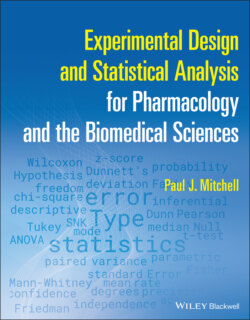Читать книгу Experimental Design and Statistical Analysis for Pharmacology and the Biomedical Sciences - Paul J. Mitchell - Страница 19
The structure of this book: Descriptive and Inferential Statistics
ОглавлениеThe process of statistical analysis is broadly divided into two principle divisions. The first, and smaller, division is entitled Descriptive Statistics and provides a range of values which allows the appropriate summary of experimental data. Such values include, for example, the Mean, Median, Mode, Variance, Standard Deviation, semi‐quartile range values, etc. and will be described in more detail in Chapters 5, 8 and 9. The second, and by far the larger division, concerns all the statistical tests that are employed to analyse data in order to draw appropriate conclusions about the relationship between different groups of values, and this division is entitled Inferential Statistics and will be the focus of the remainder of this book (from Chapter 10 onwards).
Before we continue this journey of discovery into the mystical world of experimental design and statistical analysis, I would just like to make a few comments about the approach and design taken throughout the book. To an experimental pharmacologist, statistical analysis simply provides a tool by which data obtained through robust experimentation may be understood. The purpose of this book is therefore to show the experimental pharmacologist how to use this tool: how to decide which statistical approach is appropriate for their data, how to prepare for and perform statistical analysis, and how to interpret the resulting output from the analysis. Consequently, this is very much a how‐to, hands‐on book; what it is clearly not is an academic text focused on the vagaries of statistical theory – I really have little interest in why such tests work, I just need to know which test to use and when!
You will notice that the book is organised into (I hope, at least that is the plan) logical sections. Each section will contain a description of the test being described with some examples of experimental data and their statistical analysis. There are a range of software packages available to analyse scientific data, and I dare say, you, your lecturers, Department, or Institution will each have their favourite. Each of the analysis chapters, therefore, conclude with a number of Screenshots showing the appropriate output from a limited number of statistical packages (notably GraphPad Prism, InVivo Stat, MiniTab, and IBM SPSS) of the example data. My aim (or, at least, hope!) is that you will be able to perform you own analysis of the data examples and recognise the similarity between what you see herein and from your own efforts.
Throughout this Introduction, there is one word that pops up repeatedly, and that is the term data. So, what are data? Considering that the aim of this book is to show you how to subject data to appropriate statistical analysis, it is probably most important before we go any further that you understand exactly what data are and appreciate that there are different types of data.
So, sit back and tighten your safety belt as we start our journey into the realm of data.
